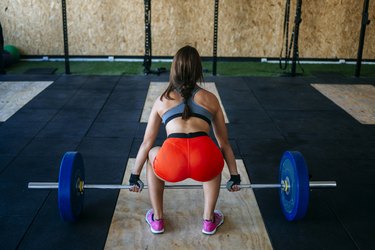
Few things in the world of fitness are more frustrating than dedicating yourself to working out but failing to see any progress. If you exercise regularly but you're still not losing thigh fat, several factors could be at play.
Evaluating your workout and lifestyle and deciding what areas to change can quickly put you on track toward fat loss. Remember, consistency is the key. No diet or exercise plan will work overnight.
Video of the Day
Video of the Day
Don't Expect Immediate Results
If you're working out without seeing any progress, it's possible that you haven't yet devoted enough time to see results. Fat loss doesn't take place overnight. A reasonable rate of fat loss is one to two pounds over the course of a week, but you can't exclusively lose this fat off your thighs.
If you lose a pound in a week, for example, the fat loss will be from several parts of your body, such as your arms, waist and legs. Even if you're losing weight at a successful rate, it might be a period of several weeks before you can track a difference in the size of your thighs.
Also, remember the 3,500-calorie rule. According to the Mayo Clinic and other health organizations, one pound of fat equals 3,500 calories. This means you must create a 3,500-calorie deficit to shed one pound. That's not something you can do in a day or two.
Think Big Picture
Taking a 20-minute walk once a week might help you feel as though you're improving your fitness — and, to a certain extent, you are. But this infrequent approach to exercise is unlikely to yield significant fat loss results.
If you use a medium-pace exercise, such as walking, as you attempt to lose weight, you must devote around 150 to 300 minutes per week to the activity, as recommended by the U.S. Department of Health and Human Services. Up-tempo exercises, such as jogging and cycling at a brisk pace, require about 75 minutes per week.
The more intense your workout, the higher your energy expenditure. High-intensity interval training (HIIT), for example, causes the so-called afterburn effect or EPOC (excess post-workout oxygen consumption), leading to a faster metabolism. Basically, you will burn more calories during and after exercise.
As the American Council on Exercise points out, this training method may boost cardiorespiratory fitness, reduce body fat mass and increase the levels of anabolic hormones in your body, making it easier to build lean mass and recover from training. All you need to do is to alternate between short, intense bursts of exercise and low-intensity activity or rest.
Choose the Right Exercises
The exercises you perform in your attempt to lose thigh fat can be the difference between success and frustration. You don't necessarily have to resort to vigorous workouts to burn fat, but those with a slow tempo can make fat loss extremely slow.
Lifting weights, for example, is beneficial as it boosts your basal metabolic rate, but the exercise itself burns calories extremely slowly. Likewise, yoga might help you feel limber and fit when you practice it, but its rate of calorie burn is negligible compared to that of jogging and swimming.
Again, intensity is the key. Beware that no exercise can spot-reduce fat, as the National Institute for Fitness & Sport points out. Doing 100 squats a day will make your legs look leaner and more defined, but you'll lose fat overall, not just from your thighs.
If you're not losing thigh fat despite eating clean and sticking to your workouts, mix up different exercises or increase training intensity. Most importantly, have patience. Keep your routine varied to prevent your body from adapting to the exercises you do.
Rethink Your Diet
Failing to burn fat, despite frequent exercise, can be the result of a high-calorie diet. To lose fat, you have to burn more calories than you consume on a repeated basis. As mentioned earlier, this process is known as a calorie deficit.
Although frequent exercise can help you work toward a calorie deficit, a high-calorie, unhealthy diet can quickly erase the positive work you do in the gym or on the road. If you feel as though you're performing the right exercises frequently enough, reduce your calorie intake by skipping high-calorie foods and see if you begin to lose weight faster.
Clean up your diet by cutting out ultra-processed foods, such as breakfast cereals, deli meats, soda, candies and other sources of added sugars. These products contain nothing but empty calories.
Replace your go-to snacks with low-calorie, high-protein foods, such as cottage cheese, veggie sticks and Greek yogurt. Protein increases satiety, keeps your metabolism up and helps preserve lean mass while on a diet.
- Centers for Disease Control and Prevention: Losing Weight
- ExRx.net: Fat Loss & Weight Training Myths
- U.S. Department of Health and Human Services: "Top 10 Things to Know About the Second Edition of the Physical Activity Guidelines for Americans"
- Harvard Health Publications: Calories Burned in 30 Minutes for People of Three Different Weights
- Mayo Clinic: "Counting Calories: Get Back to Weight-Loss Basics"
- ACE Fitness: "Benefits of HIIT Training: 8 Reasons HIIT Workouts Are So Effective"
- NIFS: "Thomas's Corner: Is Spot Reduction a Fitness Myth?"
- British Journal of Nutrition: "Dietary Protein – Its Role in Satiety, Energetics, Weight Loss and Health"
- American Council on Exercise: Weight Loss: Diet vs. Exercise